Greek caves acquire a special place in the environment and have a direct relationship with the quality of life and underground water.
The term cave is defined as any natural cavity inside the earth, to which people can have access.
Adventure and mystery. Veils whose folds embrace the interior of the Earth and stimulate the imagination of the human mind to explore. After all, the unknown and challenging had a catalytic effect, mesmerising the daring pioneers.
Standing proudly and unaltered throughout time, the interior of Greek caves reveals marvellous findings from the Palaeolithic, Neolithic and Bronze Age periods.
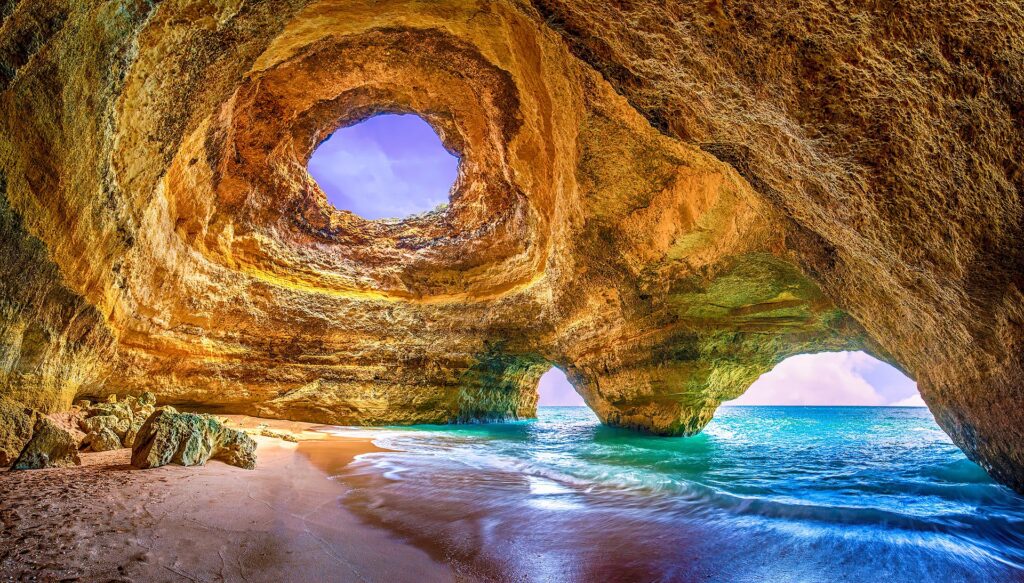
Cave of the Lakes/ Kalavryta
With natural beauty that captivates, the Cave of the Lakes unfolds its own myth since both its location, findings and unparalleled beauty weave ancient myths.
According to Pausanias, the daughters of the King of Tiryns Proetus, Lysippe, Iphinoe and Iphianassa found refuge in a cave in the Aroania, above Nonacris, when they were obsessed by madness, imposed as a punishment, because they boasted that their palace was more beautiful than the temple of Hera.
Their fury spread to all the women of the Argos region and the eldest daughter died from the hardships.The Messenian healer and seer Melampous, with secret sacrifices and purifications, led the daughters of Proetus down to a place called Lussi, which in antiquity was a flourishing town.
“Cave of the Lakes” is located in the village of Kastria in Achaia, at a distance of 17 kilometers from Kalavryta.
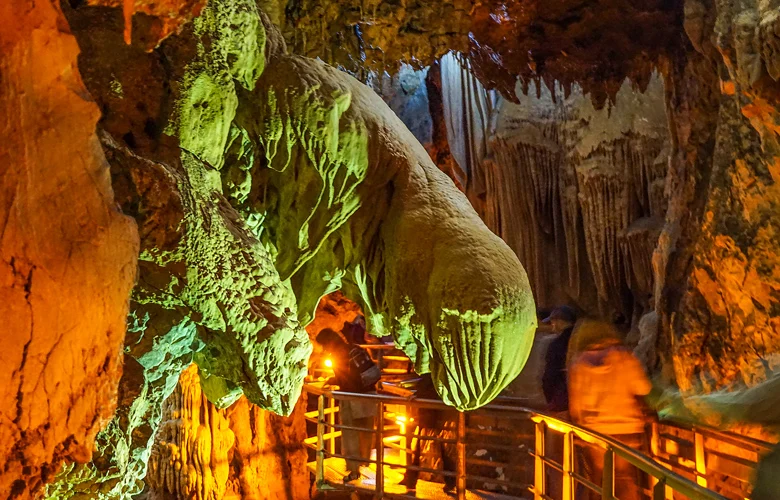
A rare creation of nature with mysterious arcades and strange stalactite formations that follows its own course in history. Fossilised human and animal bones, including Hippopotamus, are among the most important anthropological and archaeological findings.
It was first explored in 1964 by inhabitants of the community of Kastria, at the initiative of the inhabitant Vassilis Tempelis; the exploration was completed in 1965 by the Greek Mountain Climbing Association with the participation of Greek and foreign speleologists.
Proceeding further into the interior, visitors have a chance to realise the particular morphology of a cave which has been opened along a fault: hence its narrowness and very high ceiling. Moreover, one sees that the rock waterfalls are here the most common motif, since it is natural for the water to become «petrified», as it flows or rather discharges itself into the interior of the cave from different points on the sides and ceiling.
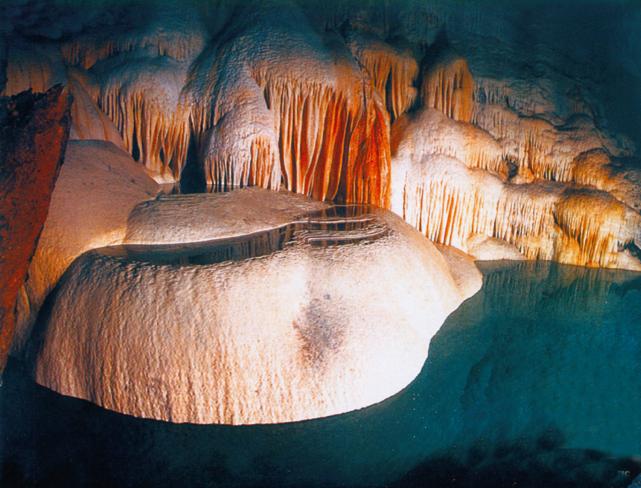
The cave’s walls are embellished with splendid stalactite complexes, which stimulate the eye and the imagination to create their own images, as the visitor goes through this stone forest full of surprises, while walking on a safe corridor. At the end of this corridor the visitor faces the «Castle», one of the most impressive formations on the ground recalling a castle’s battlements.
Perama Cave/ Ioannina
The Perama Cave of Ioannina is located at a distance of 5 kilometers from the center of the city of Ioannina in the homonymous suburb of Perama, on Goritsa hill. Its feet are bathed by Lake Pamvotida of Ioannina, well-known with the legend of Kyra-Frosini and Ali Pasha.
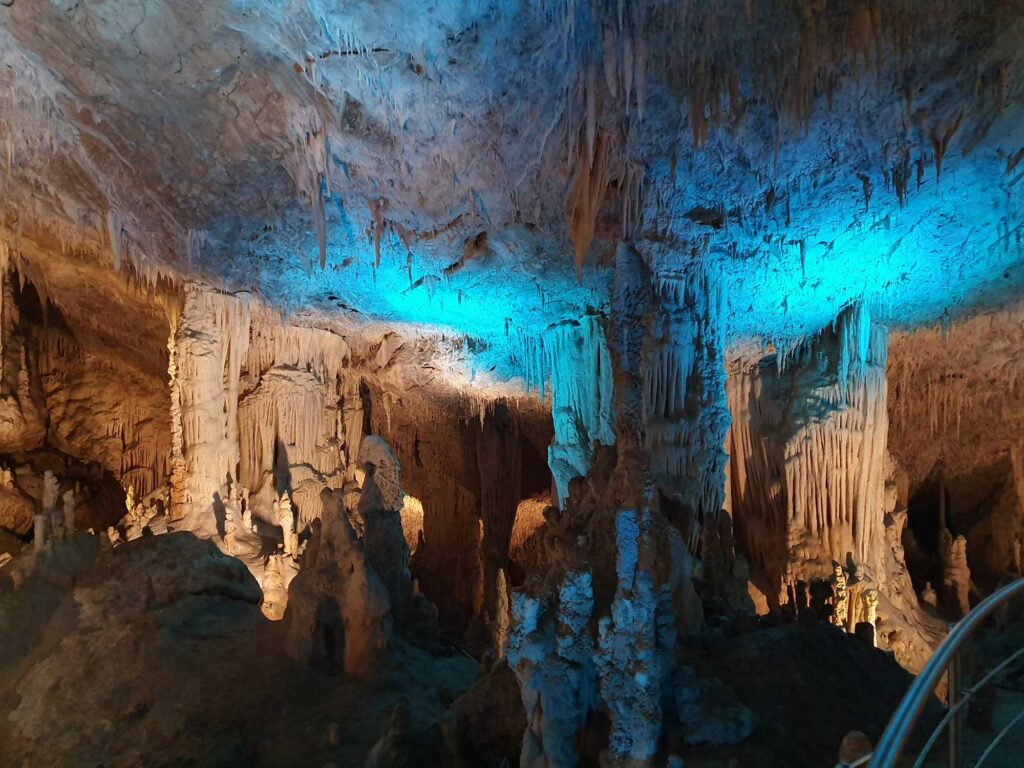
Old residents of Ioannina, refer that the entrance of the Cave was known before 1900 and that the bey Holiasis Efentis closed it around 1907 for safety reasons. Since then, however, nothing reminded of its existence. It became known during the Second World War (1940) by villagers who hid in the pits of Goritsa hill, to protect themselves from airstrikes.
A three-storey palace, with incomparable beauties and wonderful ornaments, which is among the most beautiful Greek caves in the Balkans.
Gracious corridors, extensive chambers as well as impressive and lavish ornaments that implied that it was a luxurious palace that only gods could reside. That’s why the Cave of Perama was dedicated to Pluto and Persephone.
Perama Cave lists 19 species of stalactites and stalagmites, while in other caves there are 6-10 species at most.
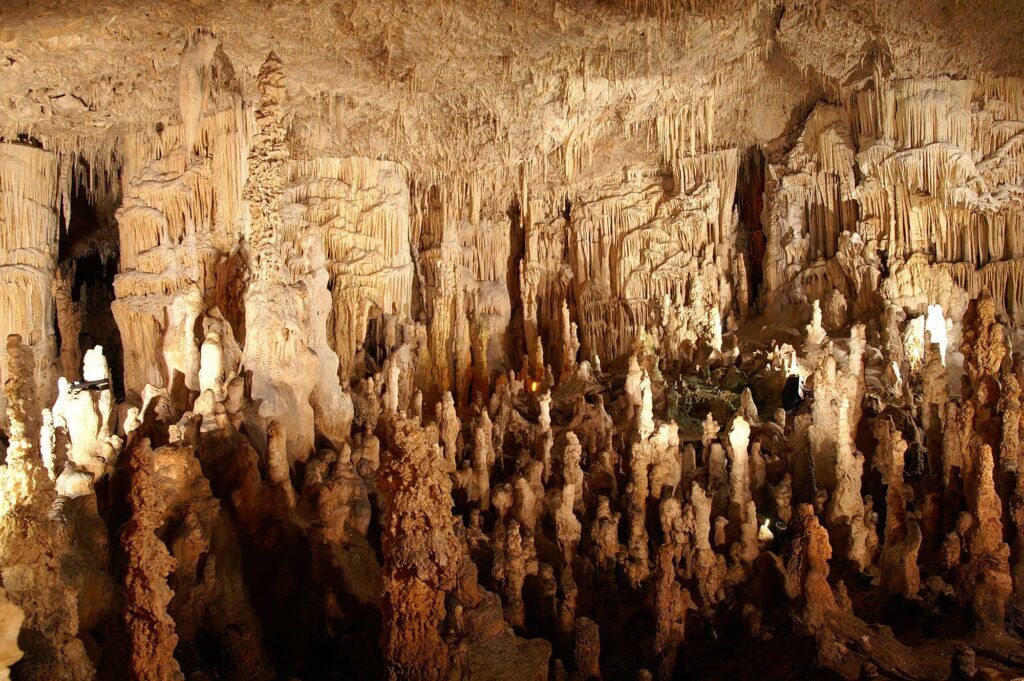
Τhe Dragon´s Cave/ Kastoria
One of the most impressive and exploited Greek caves is the Dragon´s Cave in Kastoria.
According to the tradition and narrative of the folklorist D. Giannousis (Acropolis, 11-7-54), many centuries ago, the cave was a gold mine guarded by a dragon. The monster breathed and released flames and poisonous vapours from its mouth to anyone who dared to get close to the cave’s doorstep.
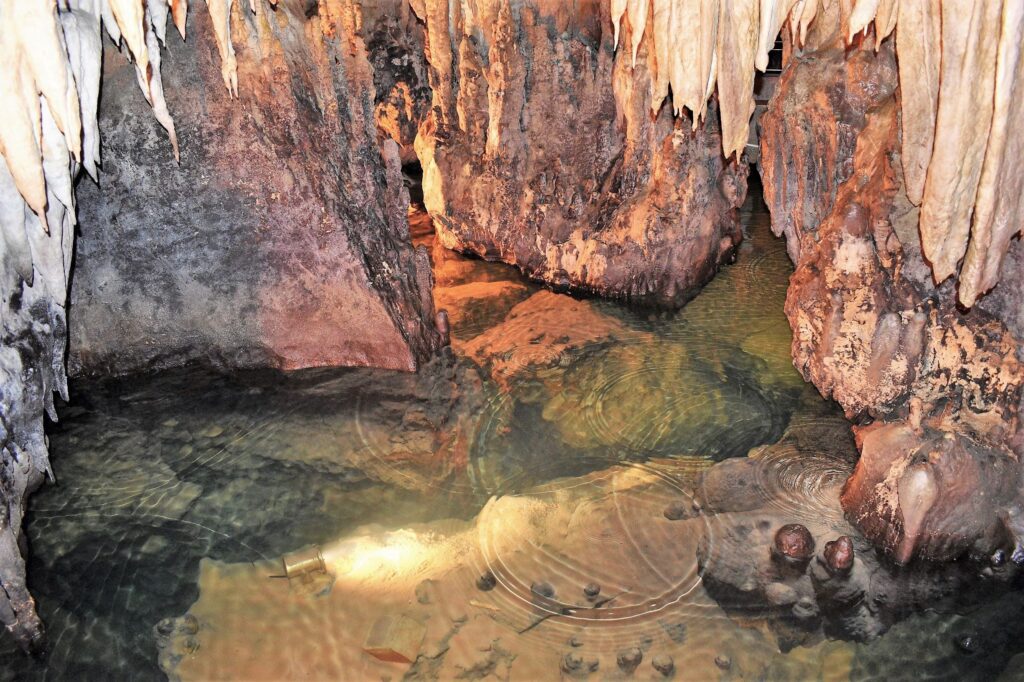
The first king of the city, Castor, seeking to entertain his guest brother Polydeuces, hoped that he could show him this cave. Thus, he made an announcement and promised a great reward to the one who would slay the dragon. Then, a young husky man showed up and decided to engage in a fierce struggle with the dragon. The young man ultimately managed to prevail by using his spear and the monster was mortally wounded, floating dead upon the surface of the lake.
The cave stretches over an accessible route of 300 meters where the visitor can marvel at an impressive number of stalactites and stalagmites. The temperature inside the cave remains stable throughout the year, ranging between 16 – 18 ⁰C, while the humidity reaching up to 90%. In order to properly replenish the air inside, no more than 12 people, are allowed to be inside the cave´s interior, at the same time.
Inside the cave, seven (7) small underground lakes are formed while it is the only cave in Greece with freshwater lakes. It features ten (10) halls (the largest one with dimensions 45x17m), three (3) bridges (one floating), and five (5) tunnels.
It is one of the most modern and sophisticated Greek caves in the Balkans, equipped with highly advanced facilities and an air recycling and climate maintenance system that allows the cave’s natural state to be maintained while preventing erosion inside and protecting its rare flora.

Antiparos Cave
The legendary Antiparos Cave is located in the middle part of eastern Antiparos and possesses a history lost in the depths of ancient Greece and the Paleolithic era.

Inside the cave there are elements that prove its prehistoric existence, such as the shells and human bones that were discovered during the archaeological excavations and can now be viewed at the Archaeological Museum of Paroikia. During the time of Alexander the Great, the cave had many visitors, as there is also an inscription which shows that Archilochus, the great lyric poet of the 7th century BC, was born in Paros.
Antiparos Cave is the only vertical cave in all of Europe with a depth of approximately 85 meters. The cave showcases the most exquisite stalactites and stalagmites making this one of the finest enchanting natural Greek cave museums in Greece. In the cave you will find the the oldest stalactite in Europe estimated to be 45 million years old!
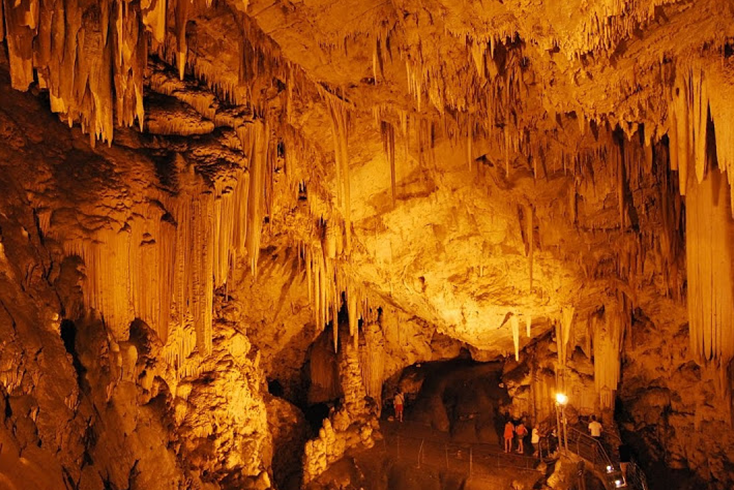
Cave of Orpheus/ Serres
The cave of the mythical Orpheus, the representative of the singing art of the lyre, is located in the region of Petroto Alistratis in the Prefecture of Serres.
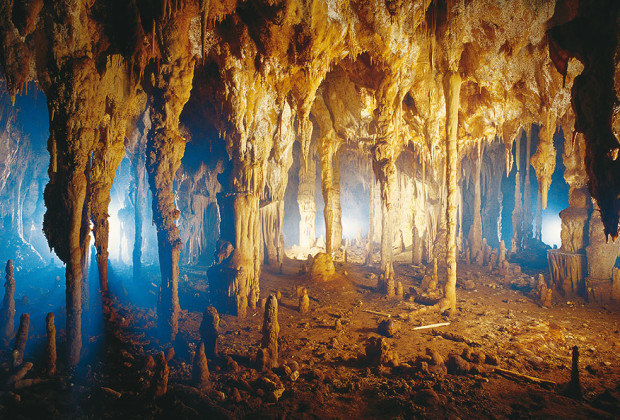
A place of unparalleled natural beauty where the slow but invincible power of water has carved 45,000 year old stalagmites into magnificent formations.
The Cave was discovered in 1976 by Austrian scientists and its exploration continues to this day. It is a horizontal, labyrinthine cave, with a total length of 300 meters and a width ranging from 20 meters to 30 meters.
Beyond the natural beauty, the Cave of Orpheus is a “chest” that protects well crucial secrets of human history. From the investigations of the Ephorate of Paleoanthropology and Speleology, findings were found inside the cave that reveal that people lived there even 9,000 years ago.

The cave was used as a place of seasonal settlement and practice of agricultural work as well as a storage place.
Cave Aggitis/ Drama
Cave Aggitis is located 23 kilometers northwest of the city of Drama and is the only exploited Greek river caves in Greece.
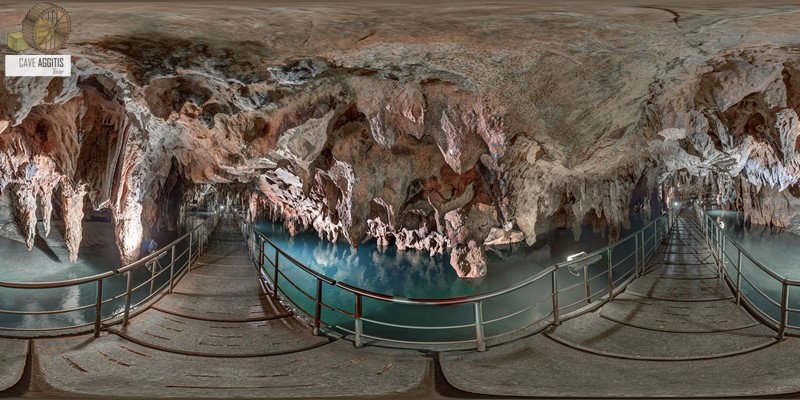
The space is impressive in Cave and visitors, as moving in a corridor over the river and against to the flow of water, monitor the natural decoration in the Cave which is dominated by white and red stalactites of various forms.
The “Hall of the Wheel,” which is currently associated with the main area of the cave with a corridor, owes its name to the presence of a large hydraulic wheel diameter 8m., which covered the water and irrigation needs of the region from the Ottoman era.
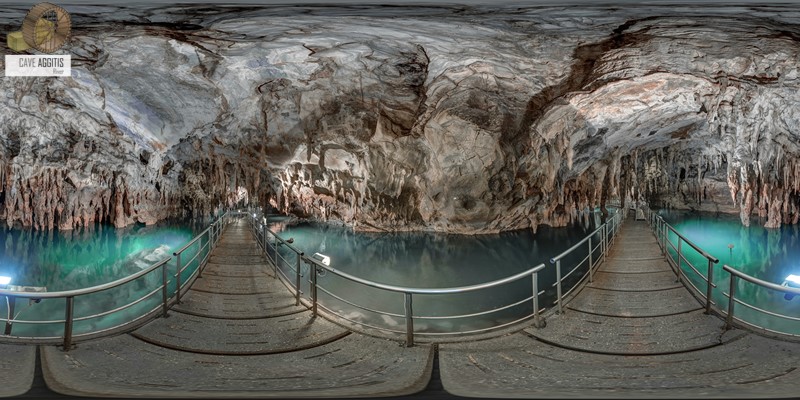
Within this impressive hall opening in the roof, measuring 8x12metres, possible entry of residents of surrounding villages and secret access from the citadel over the Cave into the river. Equally impressive is the arched opening where overflows with momentum the waters in the plain creating a cool oasis with trees, poplars and willows in the environment of cave, ideal for guests to unwind. Inside the Cave nest occasionally or permanently live 37 kind of animals, mainly microfauna, of which six species became known for the first time in the international scientific community.
